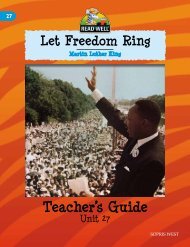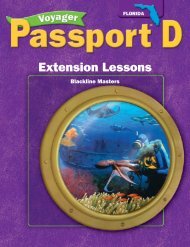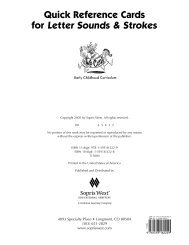Unit 19 - Voyager Learning
Unit 19 - Voyager Learning
Unit 19 - Voyager Learning
Create successful ePaper yourself
Turn your PDF publications into a flip-book with our unique Google optimized e-Paper software.
Making DecisionsGENERAL ASSESSMENT GUIDELINES1. After students read Story Reading 7, “Prickly Penelope,” give the group the <strong>Unit</strong> <strong>19</strong>Written Assessment in place of Comprehension and Skill Work. Follow theinstructions on pages 109–111 of this guide.2. While the group is completing the Written Assessment or any time duringthe day, administer the Oral Reading Fluency Assessment. Assess eachstudent individually.Optional: Graph the results of the assessment. (See <strong>Unit</strong> 7 Teacher’s Guide,pages 92 and 95.)• If the student’s words correct per minute go up, congratulate the student.• If the student’s words correct per minute go down, discuss the student’soverall improvement and help him or her identify ways to improve for thenext assessment.3. Score oral fluency responses on the Student Assessment Record. Adhere to thescoring criteria in the Assessment Manual. Use a stopwatch to time how long ittakes each student to read the Oral Reading Fluency Passage, and record errors.USING WRITTEN ASSESSMENT RESULTSResults of the Written Assessment should not be used to determine whether a studentor group of students continues forward in the program. As long as students pass theOral Reading Fluency Assessment, they should continue forward with the next unit.The Written Assessment should be used to informally monitor how well students readindependently and answer questions in writing. If any student has difficulty with theWritten Assessment, re-administer the assessment orally.If the student has difficulty answering the questions orally:• Record the types of errors (e.g., main idea, sequencing, open-ended response).• Provide explicit instruction for these types of questions during reading group, beforeindependent work, and in tutorials, as needed.1) Demonstrate (or model) appropriate responses, guide practice, and provideopportunities for independent practice.2) For inferential questions, think aloud with students—explain how you arrive atan answer.3) For literal questions, teach students to reread a passage, locate information, rereadthe question, and respond.113





